Fitting The Long Range Rifle
There are 4 major areas I look at in precision rifle fitting:
Length of Pull
Length of pull is the distance from the trigger to the rear of the stock where it contacts the shoulder. Most stocks can be corrected by adding a spacer or shortening the stock. Keep in mind the amount of clothing worn effects the LOP. A removable spacer or adjustable system is a nice way to correct for clothing changes that effect the LOP. How do you know if you have the correct LOP? Well since you asked, I'll tell you. There is no perfect way to determine for every single person what constitutes perfect LOP. Chest depth, arm length, and neck length make for unlimited combinations. When I mount the rifle I want my strong arm bent at roughly 90 degrees.
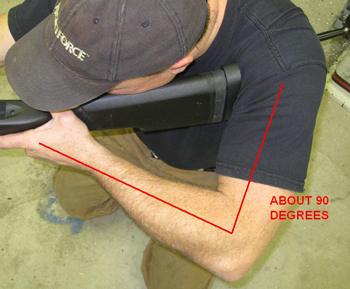
I also want my thumb to be 3-4 inches in front of my face.
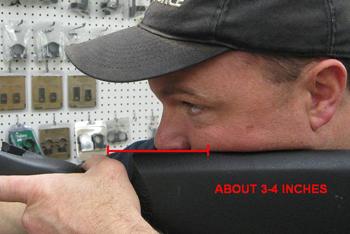
I have had a few people say they cannot mount the scope if their rifle fits correctly. If that is the case, figure out a different way to mount the scope. You don't compromise stock fit to the location of the scope. You locate the scope where the stock fits. When I am determining how I mount the rifle, I simply close my eyes and mount the rifle, then take note of where I am at when I open my eyes. I do this in fitting all aspects of the rifle.
Web To Trigger Distance
I want the center of the web to be in the grip. If it is not, you are reaching around the grip or holding it loose. Either of these conditions can affect the LOP and the placement of your eye in relation to the scope. Picture #1 is a loose grip, picture #2 is correct grip and picture #3 is a broken, reaching around too far grip.

Next, with the web in the proper location, I want the center of the pad of my index finger to contact the center of the trigger every time, from any position. If you don't have this kind of fit, the grip can be modified or there are some adjustable triggers that move fore and aft to correct this. In picture #7 the trigger finger is too far out with the very tip contacting the trigger. In picture #8, there is perfect center of the finger pad placement. In picture #9, there is too much finger through the trigger. The trigger is resting in the first crease of the finger right at the joint.

Grip
I simply want the grip to be long enough and shaped so I can get the exact same grip every time and again from any position. Some people like slight palm swells, some like none, and some like huge swells. To each their own, as long as it makes you grab the rifle the same way every time, and correctly positions the hand and trigger finger.
Cheek Weld
This is a key issue for field shooting. Some benchrest shooters would argue about cheek weld because they shoot insane groups with no cheek contact at all. That is fine on the bench but field positions are a huge difference from the bench.
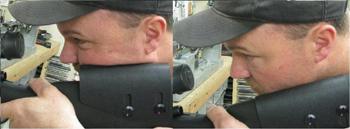
The cheek rest portion of the stock should be parallel to the bore of the scope.
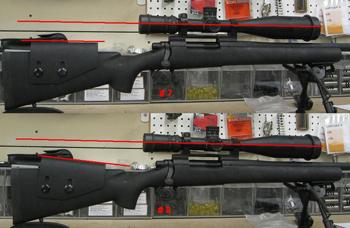
If it is not, if it drops in the front or rear, it is nearly impossible to get the same height to the scope by virtue of the fact that any given point on the cheek rest is a different height in relation to the scope. All it takes in conjunction with an angled cheekpiece to ruin a shot is a field condition or fitting issue that places the face in a slightly fore or aft location, thus changing the eye's position with the scope.
If you keep these axes parallel, it helps to minimize some differences in shooting positions. I adjust cheek height by mounting the rifle with eyes closed, then opening them to see where I am at. When it is properly adjusted, I can close my eyes, mount the rifle from or in almost any position, and see the same sight picture when opening them. It is important to note that if you have to move your position or head even the slightest bit, that you are not properly adjusted. Ultimately, when properly fitted, you should be able to be in position for long periods of time without getting neck fatigue or being uncomfortable.
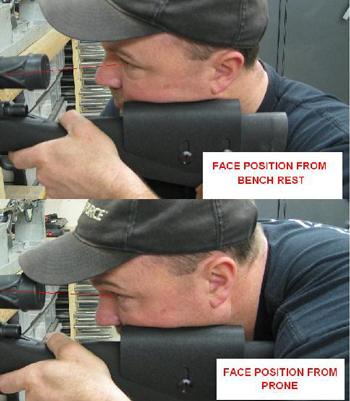
In the above photos you will see the difference in the angle from the eye to the scope. Even though there was a clear sight picture in both photos, quite clearly you're not looking through the scope the same. All that is needed to correct this is to raise the cheekpiece for prone slightly and change our bench technique slightly so it is the same. Once you feel you have it correctly adjusted, go to the range and shoot from the bench, and follow those shots up with shots from prone to confirm there is not variation in point of impact.
Last but not least, once you think you have your rifle fitted, take some notes on your adjustments and get out into the field to test them. Had our hero Andy spent even one afternoon shooting from field positions, he would have discovered he had some issues and maybe gotten an opportunity to correct them. Just remember that a properly fitted rifle should feel like an extension of the body. Hundreds of hours are spent making ammunition repeatable and exact. Big dollars are spent for the most repeatable optics. Rifles are handcrafted to be the most repeatable possible, so in the scheme of things making yourself repeatable through rifle fitting is kind of a drop in the bucket. We all know what they say about a chain only being as strong as its weakest link. Don't overlook fitting the rifle to the shooter.
Shawn Carlock is a veteran law enforcement sniper and the current USPSA national precision rifle champion. He runs his business building custom rifles and conducting precision rifle training for civilian and law enforcement interests.
Defensive Edge - Long Range Hunting Videos
Length of Pull
Length of pull is the distance from the trigger to the rear of the stock where it contacts the shoulder. Most stocks can be corrected by adding a spacer or shortening the stock. Keep in mind the amount of clothing worn effects the LOP. A removable spacer or adjustable system is a nice way to correct for clothing changes that effect the LOP. How do you know if you have the correct LOP? Well since you asked, I'll tell you. There is no perfect way to determine for every single person what constitutes perfect LOP. Chest depth, arm length, and neck length make for unlimited combinations. When I mount the rifle I want my strong arm bent at roughly 90 degrees.

I also want my thumb to be 3-4 inches in front of my face.

I have had a few people say they cannot mount the scope if their rifle fits correctly. If that is the case, figure out a different way to mount the scope. You don't compromise stock fit to the location of the scope. You locate the scope where the stock fits. When I am determining how I mount the rifle, I simply close my eyes and mount the rifle, then take note of where I am at when I open my eyes. I do this in fitting all aspects of the rifle.
Web To Trigger Distance
I want the center of the web to be in the grip. If it is not, you are reaching around the grip or holding it loose. Either of these conditions can affect the LOP and the placement of your eye in relation to the scope. Picture #1 is a loose grip, picture #2 is correct grip and picture #3 is a broken, reaching around too far grip.

Next, with the web in the proper location, I want the center of the pad of my index finger to contact the center of the trigger every time, from any position. If you don't have this kind of fit, the grip can be modified or there are some adjustable triggers that move fore and aft to correct this. In picture #7 the trigger finger is too far out with the very tip contacting the trigger. In picture #8, there is perfect center of the finger pad placement. In picture #9, there is too much finger through the trigger. The trigger is resting in the first crease of the finger right at the joint.

Grip
I simply want the grip to be long enough and shaped so I can get the exact same grip every time and again from any position. Some people like slight palm swells, some like none, and some like huge swells. To each their own, as long as it makes you grab the rifle the same way every time, and correctly positions the hand and trigger finger.
Cheek Weld
This is a key issue for field shooting. Some benchrest shooters would argue about cheek weld because they shoot insane groups with no cheek contact at all. That is fine on the bench but field positions are a huge difference from the bench.

The cheek rest portion of the stock should be parallel to the bore of the scope.

If it is not, if it drops in the front or rear, it is nearly impossible to get the same height to the scope by virtue of the fact that any given point on the cheek rest is a different height in relation to the scope. All it takes in conjunction with an angled cheekpiece to ruin a shot is a field condition or fitting issue that places the face in a slightly fore or aft location, thus changing the eye's position with the scope.
If you keep these axes parallel, it helps to minimize some differences in shooting positions. I adjust cheek height by mounting the rifle with eyes closed, then opening them to see where I am at. When it is properly adjusted, I can close my eyes, mount the rifle from or in almost any position, and see the same sight picture when opening them. It is important to note that if you have to move your position or head even the slightest bit, that you are not properly adjusted. Ultimately, when properly fitted, you should be able to be in position for long periods of time without getting neck fatigue or being uncomfortable.

In the above photos you will see the difference in the angle from the eye to the scope. Even though there was a clear sight picture in both photos, quite clearly you're not looking through the scope the same. All that is needed to correct this is to raise the cheekpiece for prone slightly and change our bench technique slightly so it is the same. Once you feel you have it correctly adjusted, go to the range and shoot from the bench, and follow those shots up with shots from prone to confirm there is not variation in point of impact.
Last but not least, once you think you have your rifle fitted, take some notes on your adjustments and get out into the field to test them. Had our hero Andy spent even one afternoon shooting from field positions, he would have discovered he had some issues and maybe gotten an opportunity to correct them. Just remember that a properly fitted rifle should feel like an extension of the body. Hundreds of hours are spent making ammunition repeatable and exact. Big dollars are spent for the most repeatable optics. Rifles are handcrafted to be the most repeatable possible, so in the scheme of things making yourself repeatable through rifle fitting is kind of a drop in the bucket. We all know what they say about a chain only being as strong as its weakest link. Don't overlook fitting the rifle to the shooter.
Shawn Carlock is a veteran law enforcement sniper and the current USPSA national precision rifle champion. He runs his business building custom rifles and conducting precision rifle training for civilian and law enforcement interests.
Defensive Edge - Long Range Hunting Videos
